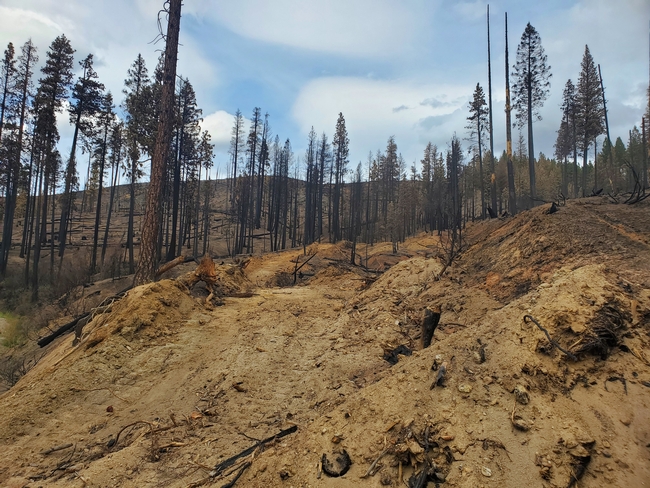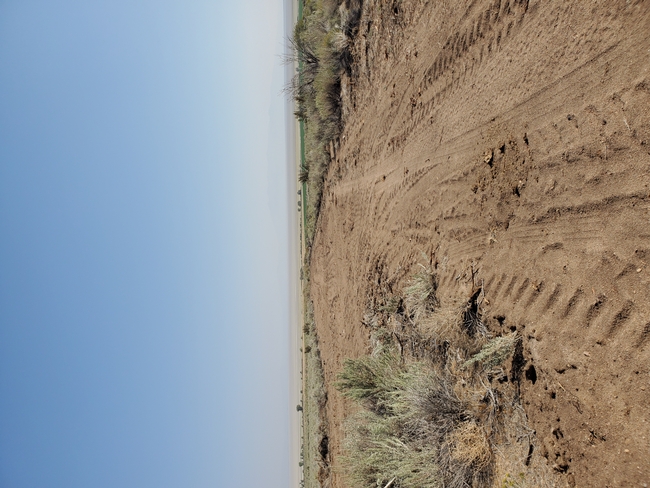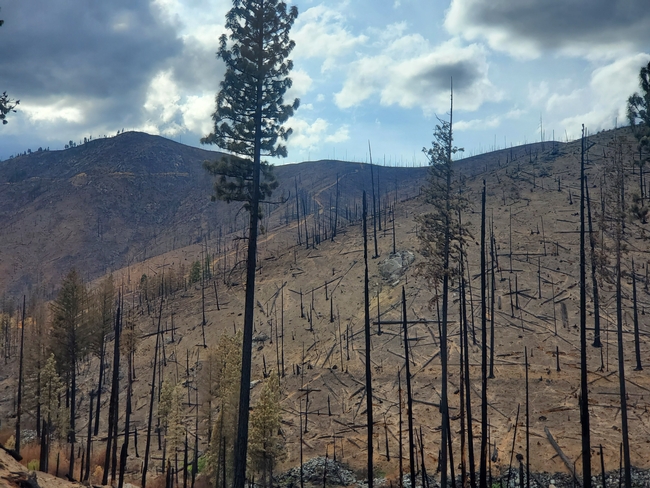I have called California Home for the past 6 years since starting this position and the past two summers are unlike any I have experienced in the west. Growing up in Colorado I remember the smokey skys from the Hayman fire and ash raining down from the High Park fire, which blackened my grandparents' property. Moving to Susanville, we had smoke and ash from the 2016 Willard fire, the 2018 Whaleback fire and the 2019 Walker fire, but none of it was unlike what I was used to back home.
Raining ash and thick air was a novel experience to many of my new friends in Susanville, who had grown up in the Midwest. Where friends I had made who were local said 2016-2019 “was nothing” compared to the 65,000 acre Moonlight fire, which filled the Honey Lake Valley with thick smoke for weeks. I thought I had experienced the stress and smoke from wildfires, but was unprepared for the past two summers.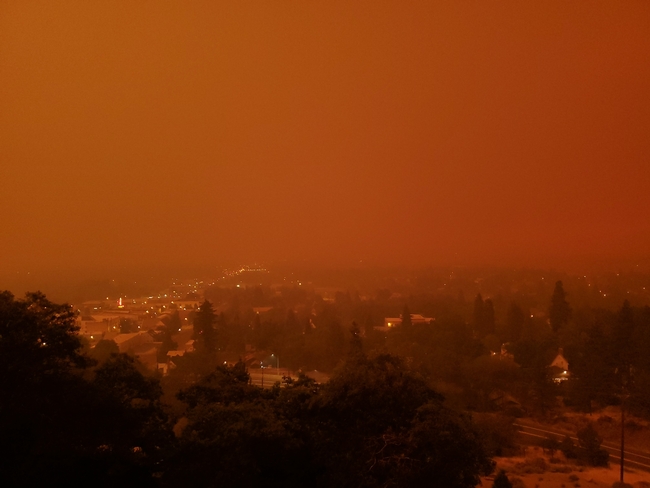
Picture one: Inspiration Point in Susanville California in the middle of the afternoon. Smoke so thick the streetlights came on and it felt like night.
During the summer of 2020 the Hog fire started right up the hill in mid-July. There were planes and lots of resources devoted to control, and while ash rained down from the sky it was just “another fire”. Summer rolled on until one night in mid-August, when I was called to my porch with the CRACK and BOOM of dry lighting. This storm ignited fires throughout the north state all at the same time, suddenly the Sheep fire was raging towards Susanville. With all of the other fires ignited by lighting, there was only a fraction of the resources devoted to suppression. It didn't seem like “just another fire,” the mood was different. People I knew were evacuated, ranchers I worked with were losing infrastructure, trees and feed. The same storm sparked the North Complex, tearing down from Quincy to Oroville chewing 318,000 acres along the way. Smoke from all of the fires was so thick from August through September, hay producers told me their third cutting yields were suppressed from lack of light.
There was little rain or snow over the winter of 2020-2021, typically the wet season. Reservoirs stayed dry, the ground was parched and even the weeds struggled to grow. The lack of moisture affected some of my annual grass research with spotty germination and some seedlings dying before being able to put on a head. Scotch thistle that typically grew 5-6 ft. tall only grew 3ft., where some patches withered never growing at all. It was dry and the start of the 2021 fire season loomed large. It sparked off with the Beckwourth complex that ripped through 105,000 acres in early July, before burning out into the brush and grasslands on the east side of the Sierra.
On July 12th, another fire started way down on Hwy 70 on the border of Butte and Plumas counties in the timber. It was named the “Dixie”. The brush and timber were bone dry and it burned with ferocity through the timber, through towns, and through fire scars from 10 years ago. It burned from mid-July into October, even with an army of brave dedicated firefighters giving it their all for months on end. It had spurts and runs that in the end it had traveled 55 miles north to Old Station, 55 miles northwest to knock on the door of Susanville and 55 miles west to the shores of Honey Lake. It burned nearly 1,000,000 acres stopping just short at 963,000.
Picture Two: Infrared imagery of the Dixie fire from the top of Dyer mountain showing the flames.
I am not a fire scientist, but a weed scientist and this is supposed to be a weed blog. During the countless hours the past two summers I spent eating smoke and praying for high humidity, the thoughts of what plants will repopulate all this burnt acreage have been at the forefront of my thoughts. How many acres had severe fire? Will the perennials resprout? How will the native seedbanks be affected? And what about our suppression efforts?
Weeds are often ruderal species, coming in after disturbance, capturing light moisture and space more efficiently than non-weedy species. When disturbance happens on a roadside, or on a landing pad in a logging operation, the impact of invasive weeds can be great. It creates a prime area for non-desirable plants to gain a foothold and depending on the species, slowly proliferate into undisturbed areas. But what happens when disturbance happens on a grander scale?
There are numerous isolated small populations of invasive weeds throughout the forests which burned. And these pockets of invasives are set up to ramp up their invasion, claiming stake to much larger portions of the landscapes now that it has been disturbed. Winter annual grasses like cheatgrass and medusahead will flourish in the burn, along with other problematic dicot species such as knapweed and thistle.
In 2007 the moonlight fire burned 65,000 acres. It was considered a large fire for the time. Much of the private land was replanted, where lots of the forest service land was left to regenerate back on it's own. When I first started this position of the local Plumas National Forest, botanists were implementing a plan for weed management. Species such as medusahead, Canada thistle, and yellow star thistle had taken hold in large parts of the burn, where on private ground cheatgrass was rampant.
Picture Three: Close up of dozer line disturbance on forested area of the Dixie Fire.
Picture Four: Dozer line through sagebrush on east side of Dixie fire.
While wildfire is a large disturbance, so are some of our firefighting suppression tactics. There were more than 6,000 brave folks fighting the Dixie fire for months. While air tankers are used for suppression when visibility and wind allows, bulldozers scraped Fireline around the clock to protect structures and direct fire. There were nearly 1700 miles of dozer line just within the Dixie fire perimeter, let alone the handline. It is a ripe opportunity for the noxious weed already there to flourish and be moved around by equipment and people. To put this in perspective the length of dozer line in the Dixie Fire is a round trip drive from Sacramento to LA, not once but twice. That is a lot of disturbance, especially considering the 1,700 miles of dozer line is only for the Dixie, and there have been millions of acres burned in over the past two summers.
Picture Five: Dozer line up the ridgeline in the distance in middle of the Dixie Burn Scar.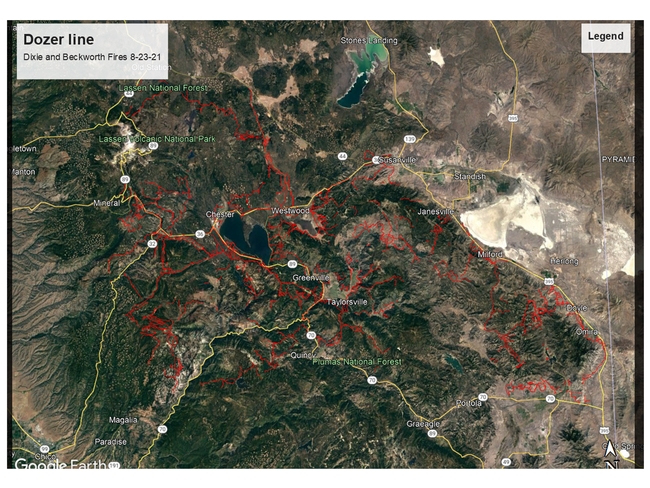
Picture Six: Dozer line from Dixie and Beckworth fires as of August 23rd.
Being someone who lives in these mountain communities, I am thankful for every mile of dozer line, that may have saved someone's home or life. But the impact of the fires and corresponding suppression efforts on invasive species spread and distributions is real. There have been numerous forest service studies looking at dozer line and increasing invasive species colonization. Generally, there is an association within increased invasive species presence around hand and dozer lines. One FS study in Montana found 73% of hand lines observed had invasive species present within their surveys, significantly higher than their control plots (Black and Landres 2011). Whether the disturbance comes from the fire or the suppression effort, the increase in invasive species through the burn scars will need to be on the minds of managers.
I know I'll be keeping my eye out for new and expanding populations of Noxious weeds in the fire scars over the coming years and praying much of the native vegetation responds favorably.
